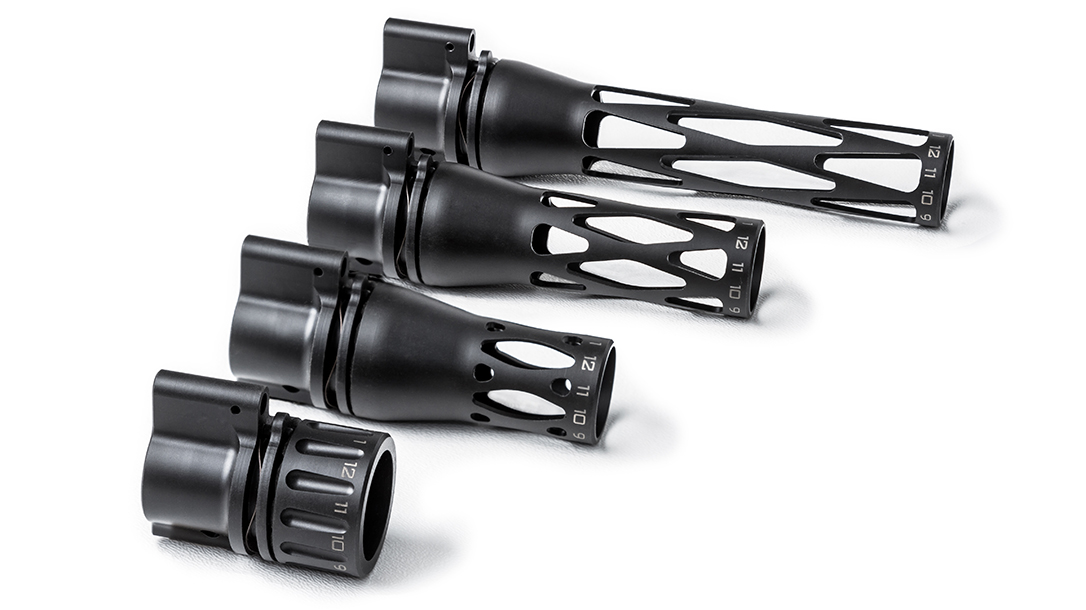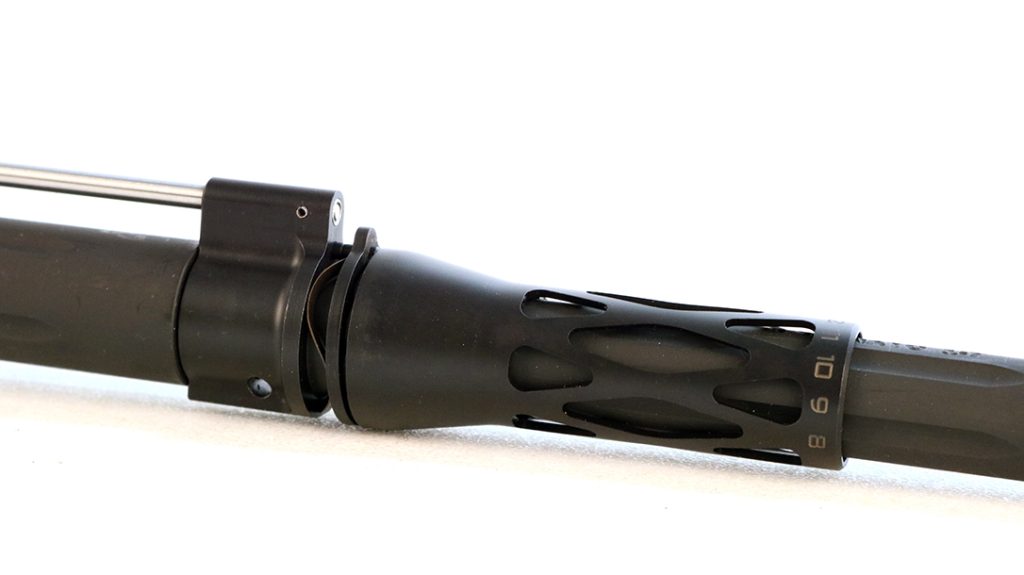The patented Riflespeed Gas Control System (GCS) is a remarkably clever system that lets you precisely meter the amount of gas that drives your favorite direct gas impingement AR rifle. By incorporating a novel valve system into the gas block, the Riflespeed GCS lets you optimize your rifle for particular loads, conditions, and applications. The Riflespeed GCS offers unprecedented control over your rifle’s performance and recoil. If you thought you already understood your favorite Stoner rifle, this takes that relationship to a whole new level.
Riflespeed Gas Control System
Common DNA
Precision is implicit in every aspect of the shooting sports. Whether your gun of choice is a $6,000 hand-built precision rifle or a Bryco beater that set you back $80 at the local Bait and Pawn, you still hope to hit what you’re aiming at. That spirit drives everything about responsible gunmanship.

Advertisement — Continue Reading Below
That common DNA means most serious gun nerds are gear heads as well. Where else but a shooting range could you spark a spirited and enjoyable conversation on something as tedious as ballistic coefficients? Serious shooters do indeed generally like to fiddle.
Back in the 1950’s Gene Stoner and a few buddies designed what would become arguably the most revolutionary firearm in human history. Comrade Kalashnikov’s farm tractor of an assault rifle will always have the numbers, but the M16 is the more elegant design. Part of that elegance orbited around the direct gas impingement operating system.
We compare and contrast direct gas guns to piston-driven designs all the time, but that’s not really fair. The traditional Stoner rifle employs a length of stainless steel hydraulic tubing to tap high pressure gas toward the muzzle and pipe it back into the action to impinge upon the bolt carrier assembly. In so doing the bolt carrier assembly becomes the piston after a fashion. It is simply in a different location and of a different design when compared to an AK, AR180, or HK G36.
Advertisement — Continue Reading Below
DIY Recoil Management
That design brings several things to the table, some more desirable than others. The relative dearth of moving parts is conducive to accuracy. Piping the gas straight into the action means less stuff to wiggle. That makes the guns shoot straight. The dark side is that all that grungy crap ends up inside the action. Tens of millions of weapons later, we appreciate that this is a mature and effective combat tool. It is simply that the direct gas impingement AR requires regular cleaning and maintenance to remain so.
The AR-15’s real magic is its unrivaled customization. Down here in the Deep South if your kid leaves for college without building an AR-15 from parts that can be viewed as child neglect. This innate modularity makes the platform ripe for optimization.
Advertisement — Continue Reading Below
Riflespeed has created a device that interdicts the direct gas system and introduces a fresh level of control over the process. These systems can be had as complete drop-in uppers or component parts you can assemble on your existing gun. The technical details are available on their website.
Riflespeed—The Details
The Riflespeed GCS consists of a custom gas block with a rotating valve. Control knobs of various lengths accommodate the particular geometry of your build, barrel, and handguard. Short versions are for rifles wherein the gas block is near the front of the forearm. The longer sort give you access when the forearm telescopes out a bit. The GCS also requires a unique straight gas tube that is available on the Riflespeed website.
If you can change the oil in a car you are overqualified to install this kit. Strip the barrel and then tap the new gas block in place. Secure it with set screws and Loc-Tite. Once you get the gas block and associated control apparatus installed reassembly is a breeze. If you have any questions there is always the miracle of YouTube.
Advertisement — Continue Reading Below
Dialing In
There is a voluminous table of proposed gas settings for various barrel types and ammo loads. However, I binned all of that. I rather enjoyed the trial and error off it all. Just start with the GCS fairly tight, fire a round, and repeat as necessary backing off until you get reliable operation. Once you find that sweet spot you can increase or decrease the gas setting to add or subtract power from the system. The control knobs are marked if you want to maintain records. The end result is the smoothest, lightest recoiling AR rifle you’ve ever hefted.
There is one consideration I encountered when building up my own Riflespeed system. The wide open starting point is, by definition, a standard gas impingement AR. Any adjustments go down from there.

Advertisement — Continue Reading Below
I tried a dissipator barrel first and found that it lacked the horsepower to drive the system reliably. The dissipator design has the gas port well forward on the barrel. As the amount of barrel remaining beyond the port drives the energy available, the dissipator is on the low end power-wise. Smaller Riflespeed replacement plungers would still accommodate that configuration. However, once I swapped to a barrel with a little length ahead of the gas port it ran like a champ. Installation took maybe half an hour all up.
Trigger Time
Once tweaked, the rifle runs like a crack-addled chipmunk. It is indeed great fun optimizing the system for whatever it happens to be eating. Everything from bulk Wolf steel-cased 55-grain blasting bullets all the way up to precision SIG 77-grain open-tipped match rounds warranted their own unique settings. Should the action ever get sluggish just open it up a notch.
A 5.56mm AR is about recoilless anyway. However, when equipped with the Riflespeed GCS you can meter that chaos down to its lowest possible impulse. Whether it’s precision shooting at distance or engaging the threat at bad breath range, the GCS gives you yet another level of control over the process.
Advertisement — Continue Reading Below
To take a line from the anti-gunners’ talking points, America is undeniably awash in guns. This is the best time in all of human history to be a gun nerd. A decent rack grade AR from your local gun emporium will run reliably and well and outlive your grandchildren. However, if you’re ready for the next level in control Riflespeed is indeed a fresh take on the traditional AR.
For more product info, please visit 3rdgentactical.com and riflespeed.com.
Technical Specs
- Caliber: 5.56x45mm
- Overall Weight: 11.4 pounds (as tested on rifle)
- Barrel Length: 20 inches
- Overall Length: 36.5/39.75 inches collapsed/extended
- Action: Riflespeed Gas Control System
- Magazine: Magpul 30-round
- Chassis: 3rd Gen Tactical
3rd Gen Tactical/Riflespeed Performance Specs
| Load | Group Size (inches) | Velocity (fps) |
| Wolf 55-gr. FMJ | 2.8 | 3,125 |
| Remington 55-gr. FMJ | 2.8 | 3,150 |
| Winchester 62-gr. FMJ | 2.0 | 3,005 |
| SIG 77-gr. OTM | 1.0 | 2,725 |
Advertisement — Continue Reading Below






















